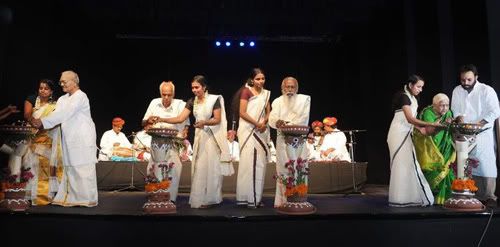
The photo above is from the inaugural function of the International Theatre Festival of Keralam (ITFoK). There was a heated debate in Facebook about the scene highlighted in this photo. The debate was about how settu mundu is being touted as the traditional attire of Keralam when it represents only the upper-caste traditional attire. The discussion was initiated by someone called Abdul Kareem and I got to see it when Sudeep Ben re-shared the photo in his FB page. After following up on the debate in the FB pages of Sudeep, Abdul Kareem and BRP Bhaskar, I posted my thoughts in one of the posts. Here it goes:
1) It is important that we ask questions about what is being celebrated as ‘traditional Kerala attire’. Every community/caste/tribe has had a different attire so it is impossible to define what is traditional and what is not. And just because one of them is being commonly celebrated as ‘traditional’ (which has happened long before the ‘disturbing’ questions about caste arose) does not mean that it must be accepted without a question.
2) Wikipedia says that ‘Mundum Neriyathum’ is “one of the remains of the pre-Hindu Buddhist-Jain culture that once flourished in Kerala and other parts of South India” (Ref: http://en.wikipedia.org/wiki/Mundum_Neriyathum). It is also said to be an adaptation of the Graeco-Roam costume called ‘Palmyrene’. So I am not sure how ‘Hindu’ it is. Upper-caste Hindus might have adopted the dress-code because they could afford it while the lower-caste being the working class couldn’t have afforded the attire.
3) The Sangeeta Nataka Academy function is a less harmful example if compared to the inaugural function of the TV programmes like Idea Star Singer which seem like a Hindu religious ceremony.
4) The remaining question is which identity we should use as a common cultural identity. Now it is dominantly upper-caste Hindu and not many have questioned this, so it continues. Whether we need to have a common pre-set cultural identity when it is projecting only one cultural identity is the next question. In this particular case, whether an ‘international’ theatre festival needs to have a local identity stamp on it is a third and more relevant question. I think it will be good to let people wear what they want to wear rather than giving a false notion of a common cultural identity.